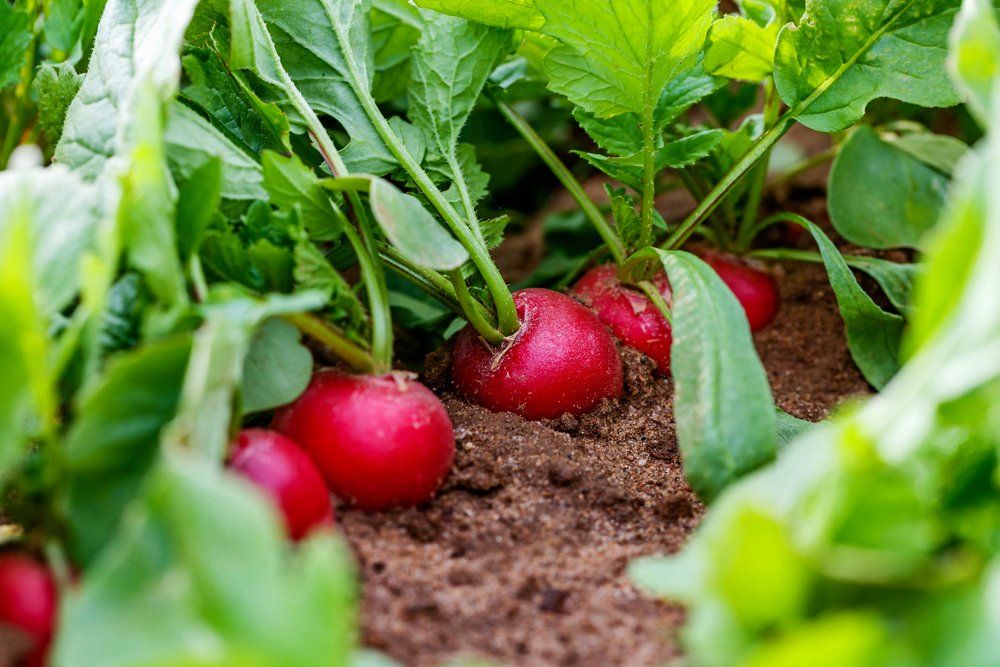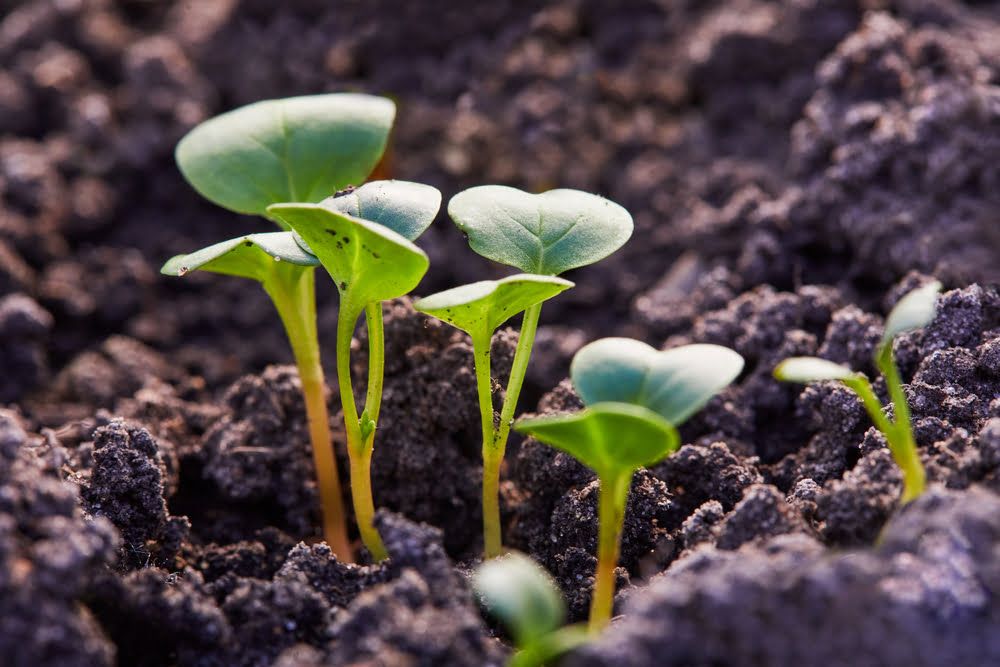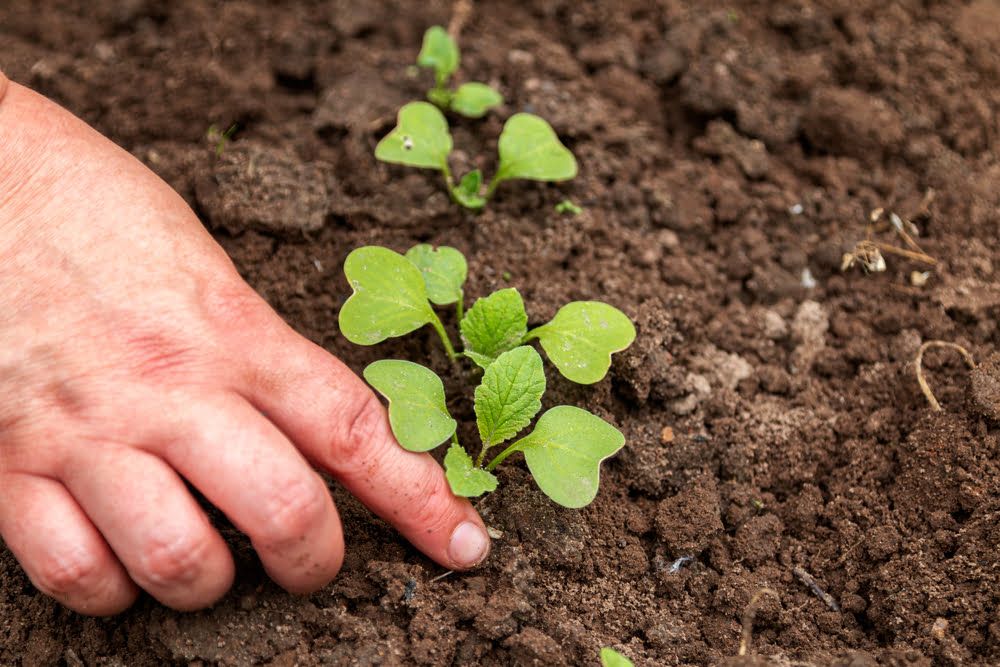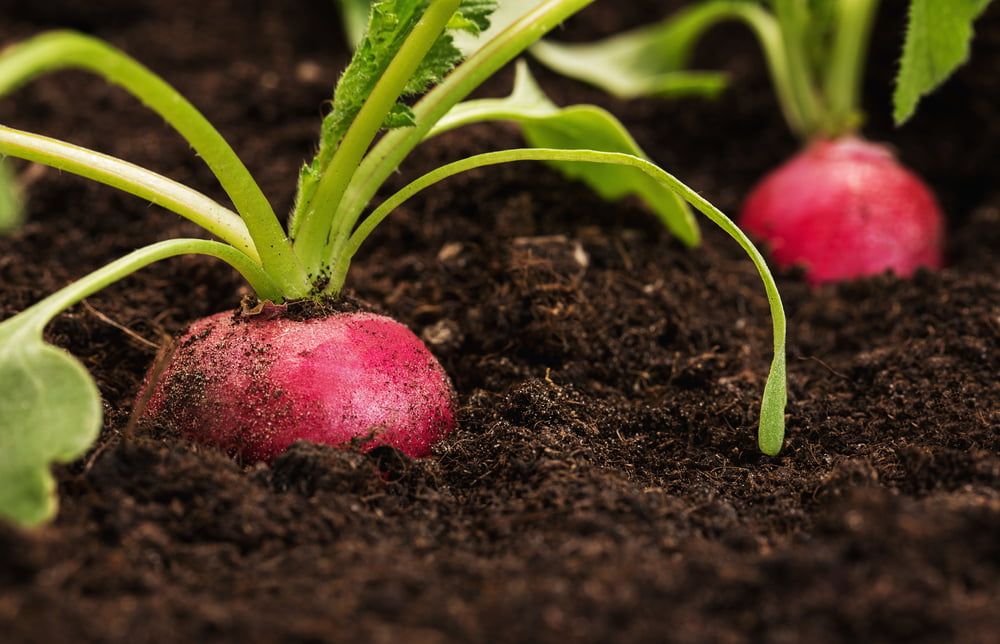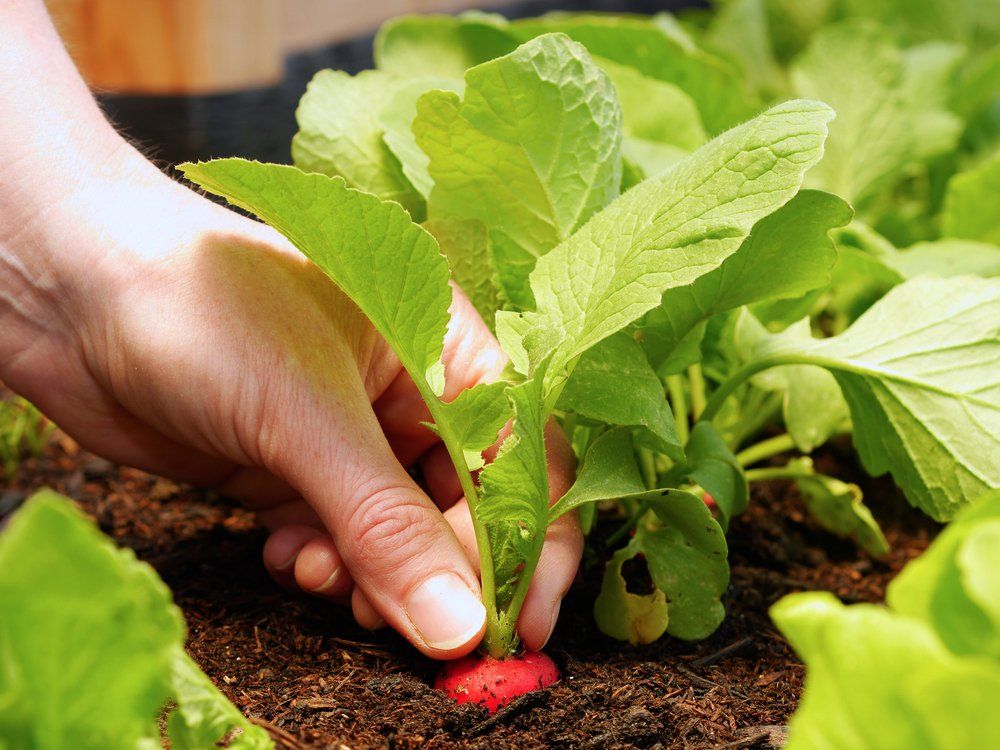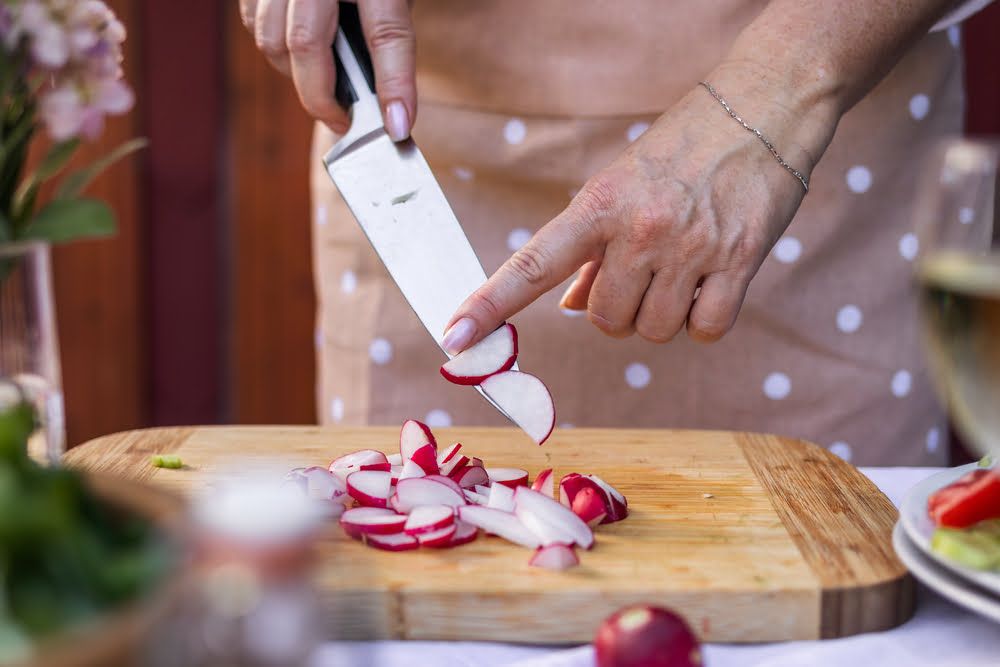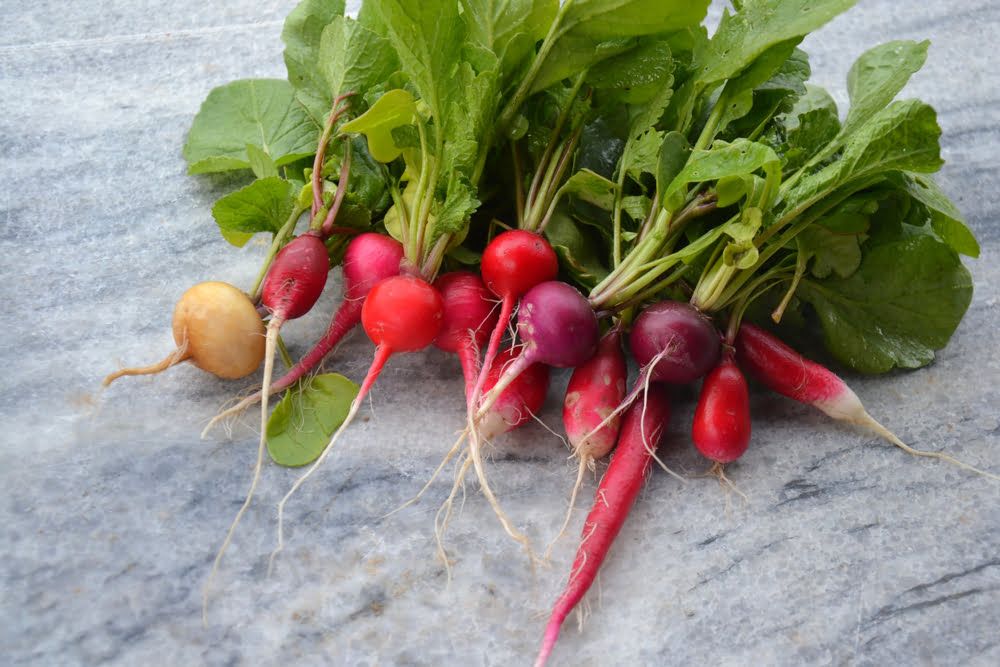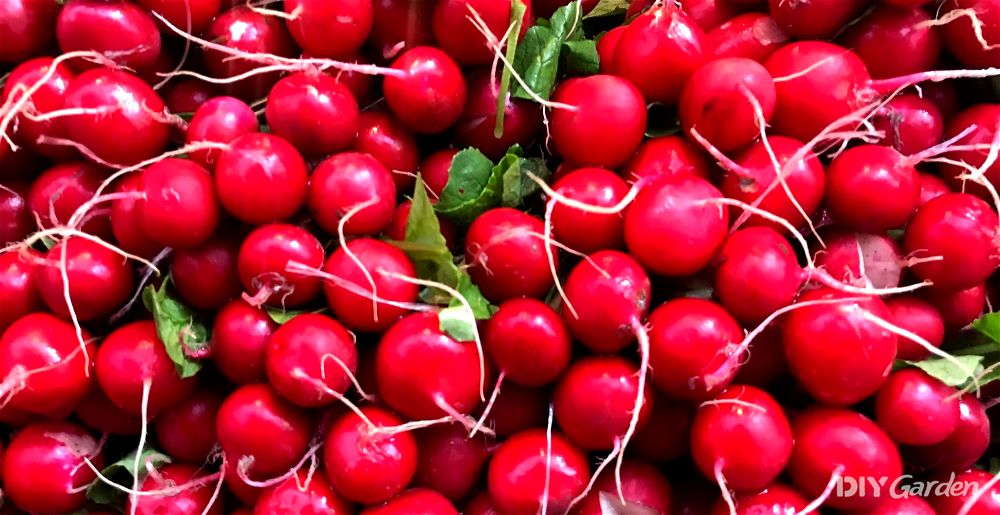
Radishes are one of the fastest-growing vegetables out there – some varieties are ready to be eaten just four weeks after sowing! They also happen to be a very low-maintenance crop, with these compact plants being perfect for filling in empty corners of your vegetable garden.
Growing Radishes: A Quick Snapshot
When to Sow – Feb-Aug
When to Plant – Mar-Aug
When to Harvest – Mar-Nov
Average Yield per Plant – 80-300g
Spacing – 5-10cm
Depth – 1cm
How to Grow Radishes at Home
Radishes are a cool-season crop, meaning that they should be grown over the spring and autumn. Once the warm temperatures of summer hit your garden, any radishes that are still in the ground will bolt. This makes the roots extremely tough, woody, and unpalatable.
However, bolting isn’t necessarily a bad thing – radish seed pods are edible too, and their crunchy yet mild flavour adds a great texture to different dishes. There are some varieties available that have been bred solely for their seed pods. Plus, all of those colourful flowers will also bring bees and other pollinators to your garden.
Radishes are loved by gardeners for being a low-maintenance vegetable, although meeting their ideal growing requirements will reward you with larger yields. Here’s how to do that:
Growing Requirements for Radishes
While cool temperatures are a must for radishes, the plants do best when grown in full sun. Six hours of sun a day is ideal, although they’ll tolerate partial shade too. Don’t be tempted to grow your radishes in heavily shaded areas – this will encourage the plants to produce extra-large leaves, at the expense of the roots. However, if you would like to try growing some radish plants solely for their edible greens, then planting some in the shade could be worth trying!
Since radishes are grown for their roots, their soil needs to be quite loose and well-draining. Anything too hard or compacted will prevent those roots from swelling properly. If you have heavy clay soil, mix in some compost to lighten it up.
Choosing a Growing Area for Radishes
Since radishes are so adaptable, they’ll grow just about anywhere in your garden if the above conditions are met.
There’s nothing wrong with having a bed solely dedicated to radishes, but you can also make the most of their fast-growing and compact nature by mixing them in with slower-growing crops, such as parsnips and carrots. In fact, as radish roots grow, they’ll help to loosen the soil for the other plants around them.
If you’re really short on space in your garden, then radishes do great in pots too. A pot depth of around 15cm is all you need for globe varieties, although you’ll need something a little deeper for cylindrical radishes. Restricted space will inhibit root growth – the bigger the container, the larger the radishes.
How to Grow Radishes from Seed
Since radishes are so quick to crop, the secret to enjoying a long harvesting period is to go with the “little but often” approach when sowing seeds. This means that you’ll need to be organised – aim to sow some radish seeds every one to two weeks, depending on how many you want to eat! On average, 8-10 radish plants per household member is a good number to aim for each time you sow some seeds.
Unlike many other vegetables, radish seeds aren’t usually started indoors. The plants hate to be transplanted, and this can actually stunt any future growth. For this reason, it’s best to direct sow radish seeds outside. This can be started about three weeks before your last frost in the spring. If you would like to be harvesting sooner than this, your seeds can be started a little earlier but the seedlings will need some protection from the elements.
Of course, if you would still like to have a go at starting radish seeds indoors, then do so in modules or individual pots. This will help to minimise root disturbance when transplanting.
How to Sow Radish Seeds in Modules:
- Fill your modules with a multi-purpose compost
- Water the modules well, making sure that excess water is draining freely from the bottom
- Lightly scatter your radish seeds over the top of your modules. Ideally, you would have one seed per module, but with radish seeds being so small, this isn’t always quite so easy
- Cover the seeds with about 1cm of compost. Don’t bury them too deep – they do best when they’re near the surface
- Lightly water once again and then place your modules in a warm location. Although radish seeds will sprout at temperatures as low as 6°C, germination is faster and more successful at temperatures of around 21°C
Since starting your seeds off indoors gives them some extra warmth, you can expect to see radish seedlings appearing in about 4-5 days. Give them a few days to grow, before snipping away the unhealthiest seedlings from each module, which allows the healthiest to thrive.
How to Direct Sow Radish Seeds Outside:
- Prepare your growing area by thoroughly weeding it and removing any large stones
- Make a drill in the ground about 1.5cm deep
- Thinly sow your radish seeds, aiming for about one seed every 1.5cm
- Gently cover the seeds back over, making sure that you don’t bury them too deeply
- If the soil is dry, then lightly water after sowing
About a week after your radish seeds have germinated, thin the seedlings down so that each plant has about 5-10cm of space on either side, depending on how large the variety is that you’re growing. Don’t be tempted to leave the extra seedlings in – this will result in small and shrivelled roots.
How to Plant Radishes Outside
Once your seedlings have a couple of sets of true leaves, you can move them outside. Harden them off for a week to acclimatise them to outdoor conditions. This will help to prevent transplant shock.
Prepare your growing area and then dig holes in the ground that are large enough to accommodate each radish module. Space the holes 5-10cm apart.
Be very gentle when removing your radish seedlings from their modules. Try to take as much of their soil with you as possible, to prevent exposing the roots. Place each plant into a hole and then cover over with soil before watering.
How to Plant Radishes in a Greenhouse
Due to warm temperatures, spring radishes aren’t usually grown in a greenhouse. They often don’t have time to mature properly before the heat causes them to bolt.
However, if you would like to grow a crop of radishes to harvest throughout the winter months, then your greenhouse will be extremely useful. Sow your winter radish varieties in August, directly into your greenhouse beds. Depending on your location, you may be able to continue sowing until the end of September.
How to Care for Radishes
Radishes are one of the easiest crops to care for. So long as you provide the basics, you’ll be harvesting juicy roots in no time at all!
Watering Radishes
Radishes need about 2.5cm of water a week. It’s important to regulate soil moisture – too much will lead to the roots splitting and rotting, while soil that’s too dry will cause the plants to bolt.
Feeding Radishes
Radishes don’t usually need a fertiliser. In fact, providing extra nitrogen could stimulate the plant into producing lots of leafy growth, but only a small root. Instead, make sure that your soil is of good quality to begin with.
Weeding and Mulching Radishes
Radishes hate competition from weeds. Fortunately, you won’t need to do much weeding while the plants are growing, so long as you weed before sowing and then mulch your young plants. A mulch will also keep soil temperature and moisture levels more consistent, which will help to improve root growth.
How to Harvest Radishes
Timing is everything when it comes to harvesting radishes. Spring radishes are best picked when they’re young. Allow the roots to expand too much and they’ll be tough and unpalatable. However, winter radishes are usually much larger and can remain in the ground for up to six weeks after maturing, so check the expected mature size for the variety that you’re growing.
Once you can see that the roots of your radish plants are about 2.5cm in diameter at the surface of the soil, pull one up to see if they’re ready. You may need to use a hand fork to loosen the soil to make the roots easier to pull.
You’ll be able to tell from the size of your test root whether or not the rest are mature. That being said, radishes can be eaten at any size, and even baby radishes are delicious.
How to Store Radishes
Winter radishes can be left in the ground for up to two months after maturity, so long as the ground doesn’t freeze. This allows you to then lift them throughout the season, preventing the need for storage.
When it comes to spring varieties, these actually store surprisingly well. One popular short-term storage method is called hydro-cooling. It requires you to place your unwashed and untrimmed radishes into a large bowl of cool water, keeping them partially submerged. Leave the bowl at room temperature and the radishes will stay fresh for 3-5 days, or 8 if you place the bowl in the fridge.
Alternatively, place your radishes into a sealed bag, along with a damp paper towel. You’ll need to first remove the greens, but these can also be stored in the same way in a separate bag. Then, put the bag into a dark corner of your fridge to keep the roots fresh for several weeks. If it’s the greens that you’re storing, these will last for up to two weeks.
If you have a root cellar with high humidity, then this is another great place to store your radish harvest. Place the unwashed roots between layers of damp sand, making sure that none of the roots are touching each other. If you check them each week and remove any that are rotting, then your radishes should last for up to three months.
How to Prepare & Cook Radishes
Radishes are so simple to prepare. Simply chop off the greens (putting these aside to use in the kitchen too), as well as the long root, and they’re ready to go.
In terms of cooking with radishes, this is a vegetable that’s so much more versatile than many people realise…
How to Cook with Radish Roots:
- Serve them raw with butter
- Shave or thinly slice them for a punchy salad ingredient
- Pickle them for a sweet and sour condiment
- Julienne them and stir them into a risotto for a crunchier finish
- Roast them with garlic
- Fry them up with some bacon
How to Cook with Radish Greens:
- Turn them into a pesto
- Sauté them with garlic and red pepper flakes
- Blitz them into a soup
- Use them as a replacement for spinach or chard in any recipe
Common Radish Problems
Radishes are generally quite problem-free. Slugs tend to enjoy munching on the leaves, but setting some beer traps up around your plants can help to deter them.
The most common issue that you may encounter is the flea beetle. These pests have a preference for cabbage leaves and will eat tiny holes in them, giving the foliage a mottled look. Fortunately, although the leaves may be pretty much inedible, flea beetles don’t really cause any damage to the roots. The leaf damage could slow growth down, but this won’t be by a hugely significant amount.
You can prevent flea beetle infestations in the future by making sure that your soil is well-watered. These pests prefer dry conditions.
Popular Radish Varieties to Grow
Radish varieties usually fall into one of two categories; spring radishes, which mature quickly and should be harvested before the heat of the summer months, and winter radishes, which can be harvested throughout the colder season.
Aim to have a mix of both types. Sow your spring radishes earlier in the year and follow these on with your winter varieties.
Some of the best varieties to grow are:
- Watermelon – very mild and sweet with white skin and pink flesh
- Daikon – a very large Japanese variety that does best in the cooler months
- Black Spanish – does well in both the spring and winter, with black skin and punchy-flavoured white flesh
- China Rose – oblong-shaped roots with pink skin and white flesh. A pungent-tasting winter variety
- Sparkler – small and flat with shallow roots, making them great for growing in a container
Conclusion
Not only are they so easy to look after, but growing your own radishes will also give you the opportunity to sample so many exciting varieties that supermarkets would never stock. Although this isn’t a vegetable that many people eat in large quantities, radishes are a fantastic way to add some extra flavour, texture, and nutrition to your meals, while also giving your garden more diversity.
